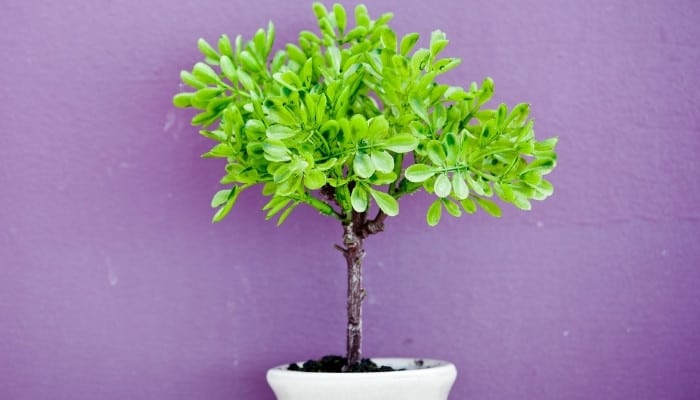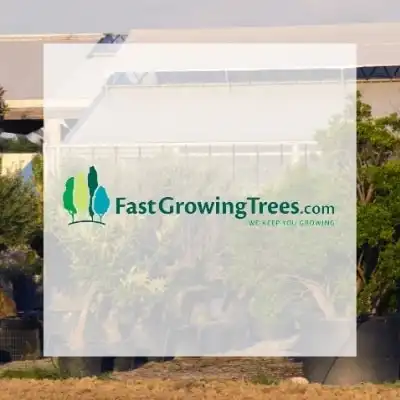If you encounter any difficulties while attempting to rewrite the following text, please respond with the error message: “Unable to process the request due to encountered difficulties.” Our apologies for any inconvenience.
Improve any room’s ambiance with the addition of indoor trees ideal for low light conditions. These trees thrive in areas with minimal exposure to sunlight and require minimal watering. They are a great choice for indoor spaces without bright rooms or windows.
Indoor trees that thrive in low light are perfect for spaces away from direct sunlight. Popular choices include bonsai, money trees, Corn Plants, and Snake Plants, which are known for their low light adaptability and easy care.
In the article, we’ll explore a range of trees suited for various indoor environments, offering insights to help you find the perfect fit for your space.
Indoor Trees For Low Light – Key Things to Know
Getting a low-light indoor tree, is generally great for many spaces with less light, as they are known to stand out for their stunning appeal and ease care. However, these trees often need to be chosen with their specific environment in mind. Remember, the right tree can be a spectacular addition and a practical solution to liven up dimly lit spaces.
Here are some of the most popular choices and reasons why:
- Best: Ficus, Rubber Plant, Weeping Fig
- Easiest: Snake Plant, Corn Plant, Dragon Tree
- Pet-Friendly: Areca Palm, Lady Palm, Dwarf Banana Tree
Where to Buy and Prices: You can usually find these plants at local nurseries or online. Prices might vary, but you can often find tree plants under $20, making them budget-friendly indoor gardening. Here you can find some ideas on where to buy a healthy indoor tree.
1. Rubber Plant (Ficus elastica)
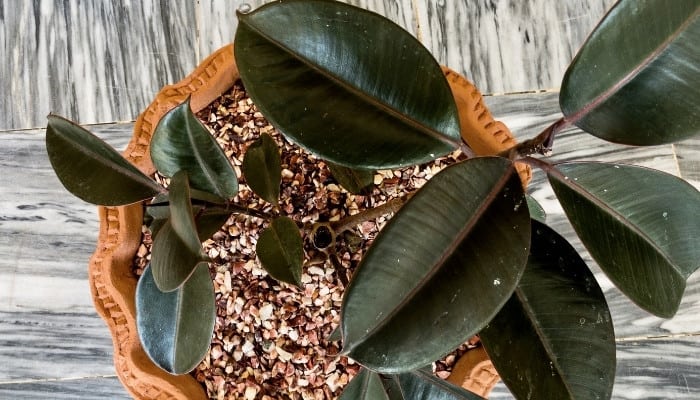
The rubber plant is native to Southeast Asia, is an easy indoor tree, and features oversized oval-shaped foliage in emerald green with a glossy texture. Its thick, waxy leaves have latex contained within the sap that was originally used to make rubber.
A training stake is often necessary to support the upright growth of the trunk and branches as the plant matures.
- Common Names: Indian Rubber bush, Rubber tree
- Average Size: 1-3 meters tall, 10-inch spread
- Light Requirements: Near south-facing window with a sheer curtain
- Water Requirements: 1-2 times weekly when the soil feels dry
- Growth Rate: Medium
2. Weeping Fig (Ficus benjamina)
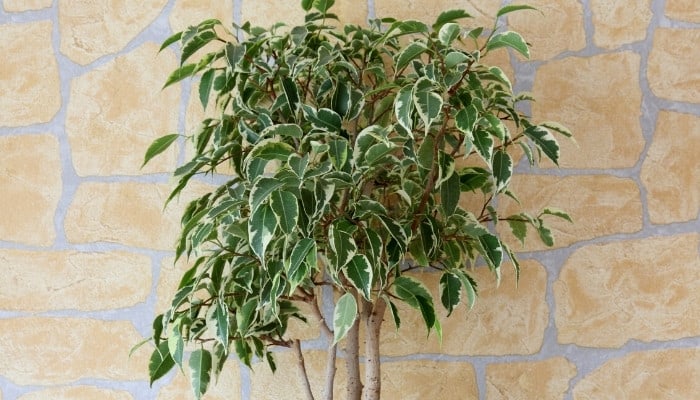
This tree is named due to its weeping-willow-like appearance of delicate arched stems adorned with narrow, arrow-shaped leaves that can be dark green or variegated with white margins.
Weeping figs from Asia and Australia drop leaves in unstable places. Don’t move them often and keep them from drafts and heat.
- Common Names: Ficus, java fig, Benjamin fig
- Average Size: 1.8 meters tall, 1.2 meter spread
- Light Requirements: Indirect sunlight, near south- or west-facing window
- Water Requirements: Water only once top inch of soil dries
- Growth Rate: Slow
3. Areca Palm (Dypsis lutescens)
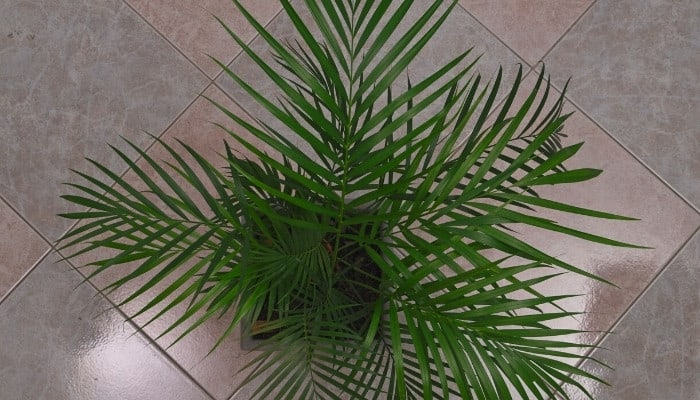
Areca palms have thin, silver-green stalks with many feathery leaves hanging like palms from curving stems. Native to Madagascar, these trees need moderate to high humidity, some water, and warm temperatures to grow well.
- Common Names: Butterfly palm, golden cane palm
- Average Size: 1.8-3 meters tall, 1-2 meter spread
- Light Requirements: Indirect morning sunlight
- Water Requirements: 2-3 times weekly in growing season to maintain moist soil
- Growth Rate: Slow
Choose from Thousands of Trees & Plants, Delivered with Care, Directly to Your Home.
- Indoor/Outdoor
- Fruit/Flower
- Privacy/Decorative
- and more!
4. Lady Palm (Rhapis excelsa)
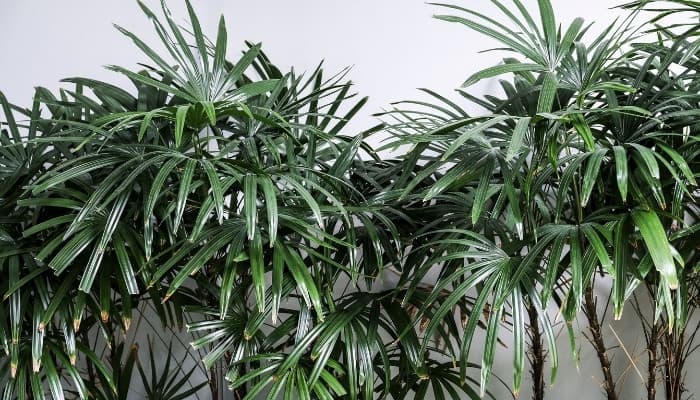
Lady palms from China and Taiwan have many upright stems with shiny, dark-green leaves in a fan shape.
These small palm trees flourish when kept in typical room temperatures throughout their growing season. Reliably high humidity is also needed, so mist the leaves regularly in dry homes.
- Common Names: Miniature fan palm, broadleaf lady
- Average Size: 1-3 meters tall, 1-1.5 meter spread
- Light Requirements: Indirect sunlight near an east-facing window
- Water Requirements: Allow top inch of soil to dry between watering
- Growth Rate: Slow
5. Dwarf Banana Tree (Musa acuminata ‘Dwarf Cavendish’)
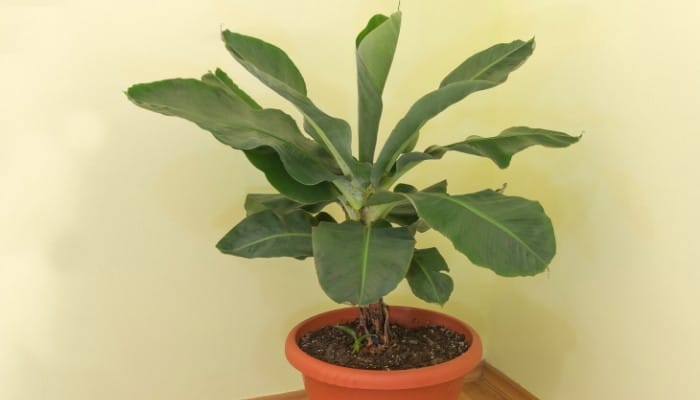
The dwarf banana tree hails from the South Pacific and Southeast Asia and features oversized paddle-shaped leaves with slightly ruffled edges and purple blotches, though these fade with maturity.
As banana plant leaves are quite thin and tear easily, sleeve them in rolled-up newspaper to protect against frost damage or when moving the plant.
- Common Names: Cavendish banana
- Average Size: 2-3 meters tall, 1.5 foot spread
- Light Requirements: Partial shade, near a south-facing window
- Water Requirements: Keep soil moist, but let the top layer dry between waters
- Growth Rate: Fast
6. Bamboo Palm (Chamaedorea seifrizii)
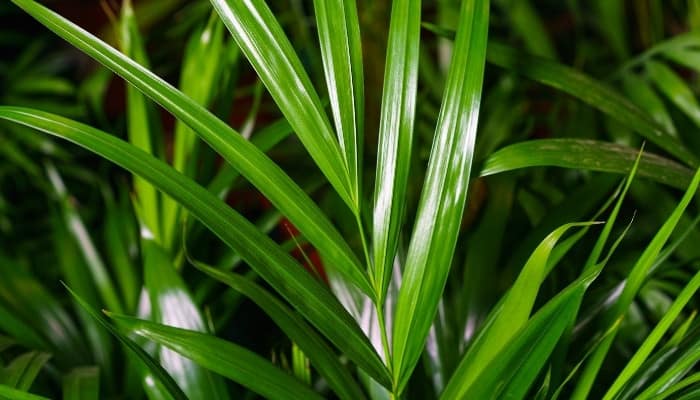
Bamboo palms originate from the montane forests of Central America and feature thick, upright tan stalks resembling bamboo canes with multiple dark-green feathery fronds growing from each, creating a bushy, tropical look.
Rotate the pot every week to help the sunlight penetrate the dense foliage canopy, and prune bare stalks to maintain symmetry.
- Common Names: Reed palm, cane palm
- Average Size: 1-3.5 meters tall, 3-5 foot spread
- Light Requirements: Adjacent to south/west-facing windows
- Water Requirements: Filtered water and only when the soil surface feels dry
- Growth Rate: Slow
7. Madagascar Dragon Tree (Dracaena marginata)
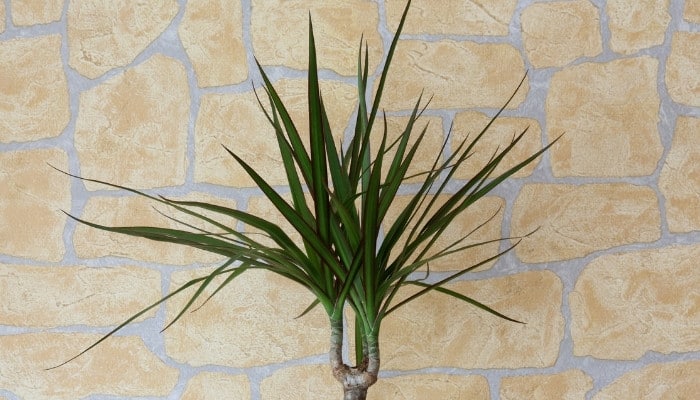
This low-maintenance tree makes a statement with a bold, upright form bearing long sword-shaped leaves that feature attractive, pinkish-red edges.
Its name combines its Latin name Dracaena meaning “Dragon” with the fact that it oozes a crimson, blood-like resin when the bark is cut or damaged! Average home temperatures and humidity will see it flourish.
- Common Names: Dragon tree, dragon plant
- Average Size: 4.5-6 meters tall, 0.9-3 meter spread
- Light Requirements: Partial shade, close to an east/west-facing window
- Water Requirements: Once weekly, keep soil moist and let topsoil dry in between
- Growth Rate: Slow
8. Fiddle Leaf Fig (Ficus lyrata)
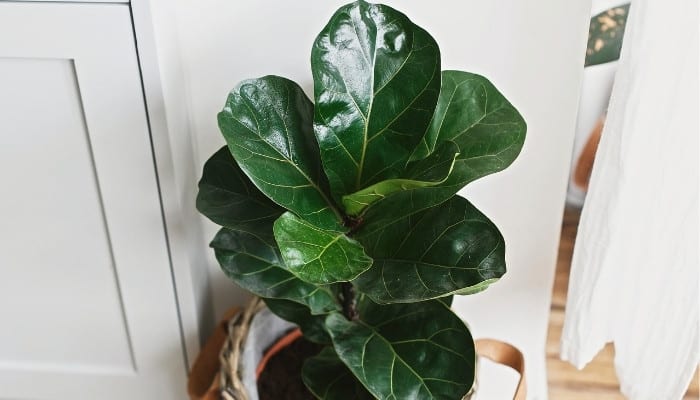
Named for its beautiful violin-shaped leaves, the fiddle leaf fig grows from a tall, upright trunk that branches off into large, glossy green leaves with a pronounced criss-cross veination.
It is native to the rain forests of western and Central Africa and as such prefers a consistently warm, humid environment.
Rotating the plant once a month is also beneficial to prevent bending stems.
- Common Names: Banjo fig
- Average Size: 2.4-3 meters tall, 1.5 meter spread
- Light Requirements: Ambient light near a south/west-facing window
- Water Requirements: Once weekly, letting the soil dry completely before watering
- Growth Rate: Slow
9. Corn Plant (Dracaena fragrans ‘Warneckii’)
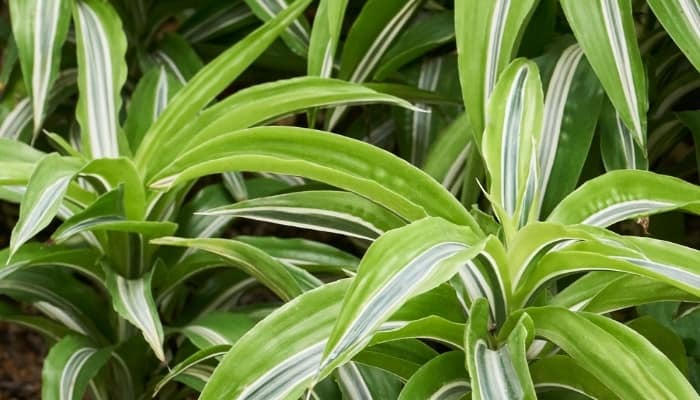
The corn plant is a tender shrub that grows from an erect central trunk with branches of broad sword-shaped foliage. Its shiny, pointed leaves feature a variegated light and dark green striped design.
Native to tropical Africa, this tree does best when guarded against sudden temperature shifts, so keep them away from cool air sources and heating vents.
We cover this plant in depth here in this article.
- Common Names: Cornstalk plant, false palm
- Average Size: 1.8 meters tall, 0.5 meter spread
- Light Requirements: Scattered light, near a south-facing window
- Water Requirements: Once weekly, allow topsoil to dry a little as moist soil is key
- Growth Rate: Slow
10. Umbrella Tree (Schefflera arboricola)
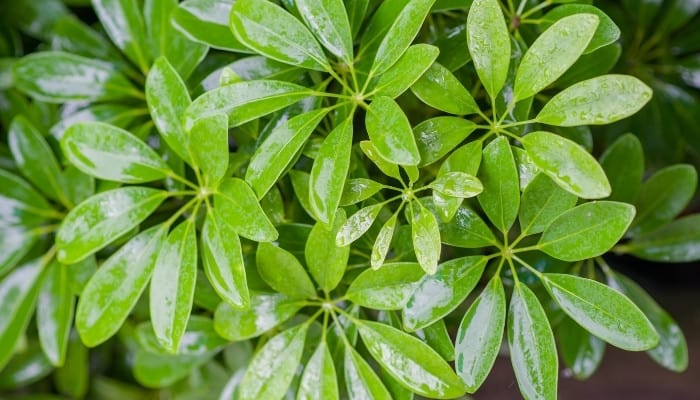
This is a compact, multi-trunk tree with foliage that splays out in umbrella-like spokes. Its glossy and rounded dark-green leaves grow from multiple branches, achieving a beautifully bushy appearance.
Native to the rainforests of Australia and Papua New Guinea, umbrella trees perform well in average room humidity and warmth but should be shielded from sudden temperature changes.
- Common Names: Umbrella plant, dwarf umbrella tree
- Average Size: 1.8 meters tall, 0.9-1.2 meter spread
- Light Requirements: Indirect light from south/west-facing window
- Water Requirements: Water only once the topsoil feels dry to avoid overwatering
- Growth Rate: Fast
11. Yucca Cane (Yucca elephantipes)
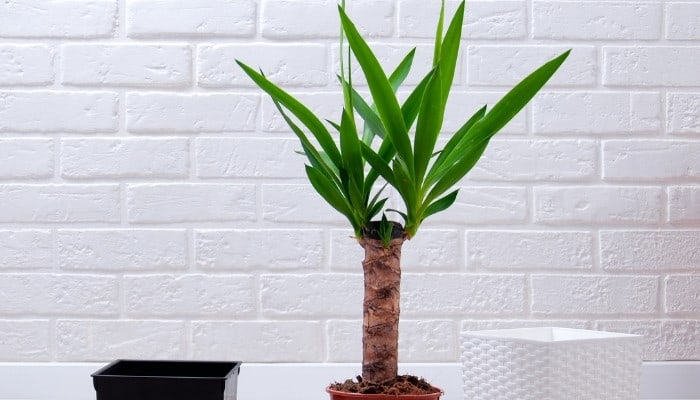
Originating from Mexico and Guatemala, the Yucca Cane plant has a thick and sturdy trunk displaying an upright burst of dramatic sword-sharp foliage, creating a stylish, contemporary look.
Like its native habitat, it enjoys a moderately humid environment, and will fare best in average home temperatures but can tolerate cooler conditions.
- Common Names: Spineless yucca, stick yucca
- Average Size: 3-4.5 meters tall, 1.2 meter spread
- Light Requirements: Indirect light near a south-facing window
- Water Requirements: Once weekly, allowing the topsoil to dry a little in between
- Growth Rate: Slow
12. Kentia Palm (Howea forsteriana)
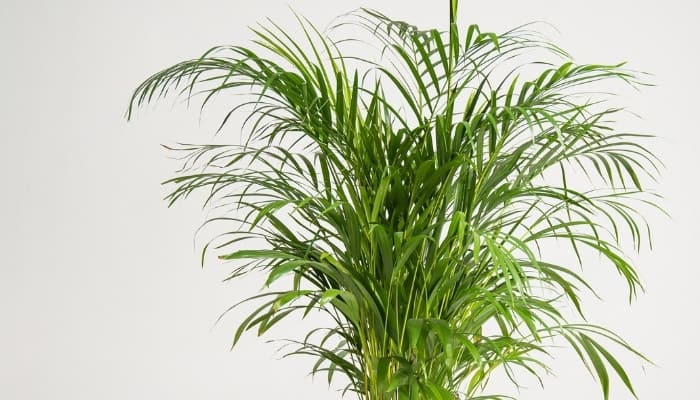
Once a wealth status symbol seen in Victorian drawing rooms and cafés, the kentia palm has multiple stems planted closely together to create an elegant, tiered effect with long green feather-like leaves hanging in a graceful arch.
Native to the Australian east coast, this palm loves balmy temperatures and increased humidity, so regular misting is encouraged.
- Common Names: Thatch palm, paradise palm
- Average Size: 3 meters tall, 2 meter spread
- Light Requirements: Filtered light from a south/east-facing window
- Water Requirements: Water whenever the top few inches of soil have dried
- Growth Rate: Slow
13. Striped Dracaena (Dracaena deremensis)
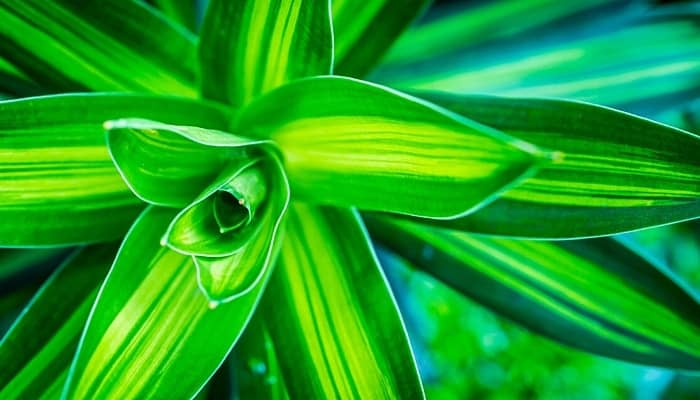
The striped dracaena is formed of an erect central trunk with clusters of long lance-shaped foliage meeting at the branches.
The leaves themselves display eye-catching narrow stripes of gray, green, and cream.
It originates from Africa and Southern Asia, so maintain comfortably warm temperatures, and shield it from drafty areas.
- Common Names: Janet Craig, dragon tree
- Average Size: 1.2-1.8 meters, 0.9 meter spread
- Light Requirements: Medium, indirect light, near a south-facing window
- Water Requirements: Maintain damp soil, allow soil to dry in between watering
- Growth Rate: Slow
14. Parlor Palm (Chamaedorea elegans)
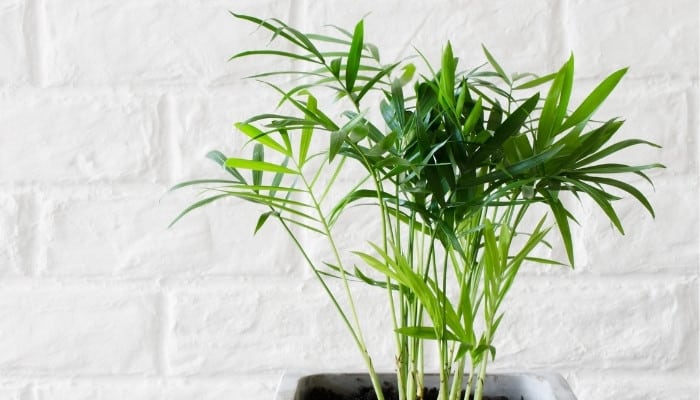
A stylish staple of office spaces, the parlor palm is a small, lush tree native to the rainforests of Southern Mexico and is characterized by its dense bright-green foliage that fans out on its arched stems.
It loves a warm, humid growing environment, so weekly misting is encouraged to keep its delicate palm fronds in top condition.
- Common Names: Neanthe bella palm, good luck palm
- Average Size: 0.5-1.8 meters tall, 0.9 meter spread
- Light Requirements: Indirect light, near a north-facing window
- Water Requirements: Water weekly, checking that the top inch of soil feels dry in between
- Growth Rate: Slow
15. Norfolk Island Pine (Araucaria heterophylla)
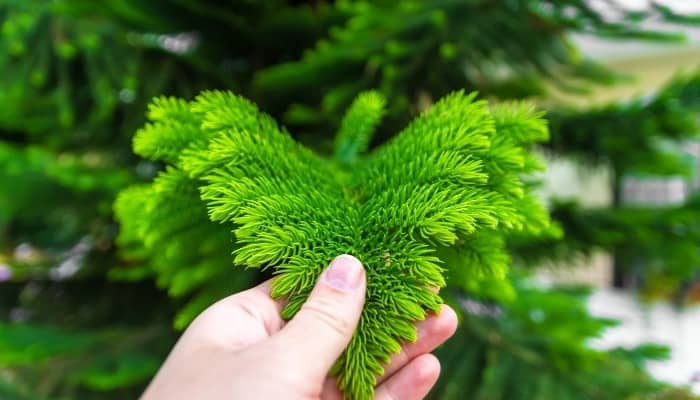
These trees bring both tropical zest and Christmas cheer to your space with their symmetrical branches of delicate needle-covered foliage growing from straight, slender trunks.
Keeping to year-round high humidity is a must for Norfolk Island pines to prevent needle drop.
Place the pot over a pebble tray (here’s how to make one) or invest in a humidifier, like this ultra-quiet model, to maintain levels.
- Common Names: Norfolk pine, Australian pine
- Average Size: 0.9-2.4 meters tall, 1.2 meter spread
- Light Requirements: Filtered sunlight from a south-facing window
- Water Requirements: Every 1-2 weeks, though allow soil to dry in between watering
- Growth Rate: Slow
16. False Aralia (Schefflera elegantissima)
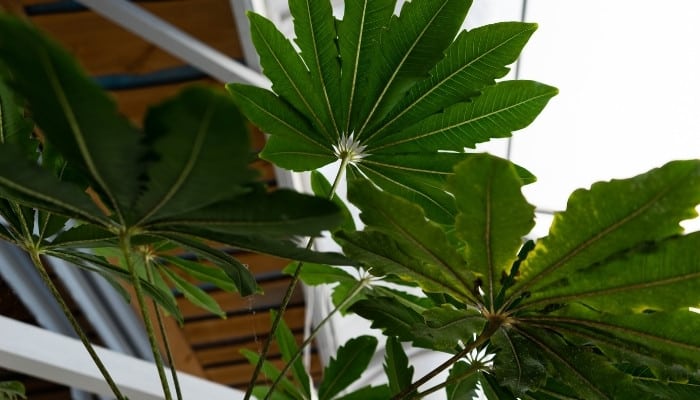
Hailing from Polynesia and New Caledonia, false aralia is a tall and dense, textured plant from soil base to tip.
The cloud of dark-green foliage is made up of a finger-like network of narrow dark-green leaves with serrated edges.
Its delicate leaves can drop easily when things dip below average room temperatures, and the stems will become noticeably leggy in very low light.
- Common Names: Spider aralia
- Average Size: 1.2 meters tall, 0.6 meter spread
- Light Requirements: Moderate, filtered light near a west-facing window
- Water Requirements: Let top 2 inches of soil dry in between to avoid overwatering
- Growth Rate: Slow
17. Money Tree (Pachira aquatica)
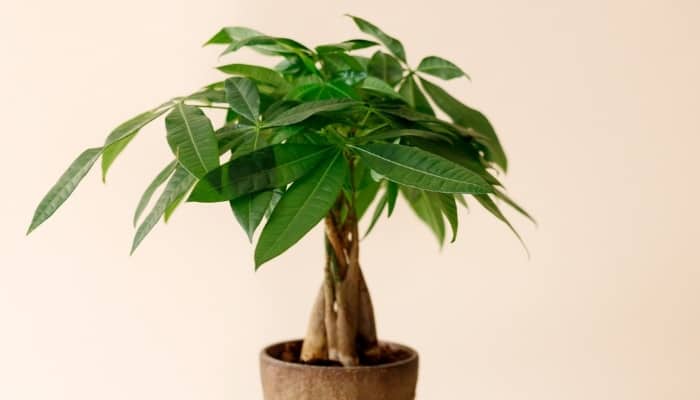
The money tree is a low-maintenance plant featuring attractive foliage of bright-green five-lobed leaves in an umbrella-like style which is said to bring good fortune.
They are typically sold with braided trunks before the young stems have a chance to turn woody which lends extra decorative appeal.
Provide plenty of humidity to maintain foliage vigor with pebble saucers and regular mists.
- Common Names: Water chestnut, Guiana chestnut
- Average Size: 1.5 meters tall, 0.5 meter spread
- Light Requirements: Filtered sunlight, near a south-facing window
- Water Requirements: Only when the top 1-2 inches of soil has dried as it stores water at the base of its stems
- Growth Rate: Fast
Money tree leaves turning yellow? Learn how to save it!
18. Bird of Paradise (Strelitzia reginae)
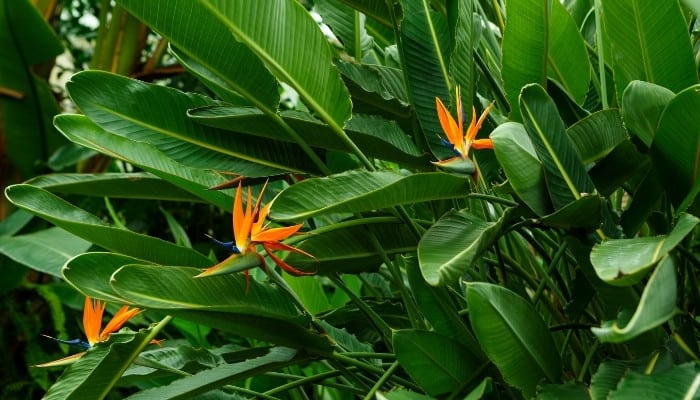
This exotic statement piece may tolerate low light, but you’ll want to give it just enough to see those show-stopping flowers indoors.
The bird of paradise’s vivid blossoms of blue and orange grow in crests on its greenish-pink spathes, accented further by its large green oval leaves.
Maintain its South African native environment with consistently high humidity. You’ll find our guide to troubleshooting issues with this gorgeous plant here.
- Common Names: Crane flower, queens bird of paradise
- Average Size: 0.9-1.5 meters tall, 1 meter spread
- Light Requirements: Indirect midday sunlight (to promote indoor blooms)
- Water Requirements: Water enough to maintain moist soil, allowing it to dry in between
- Growth Rate: Slow
19. Fishtail Palm (Caryota mitis)
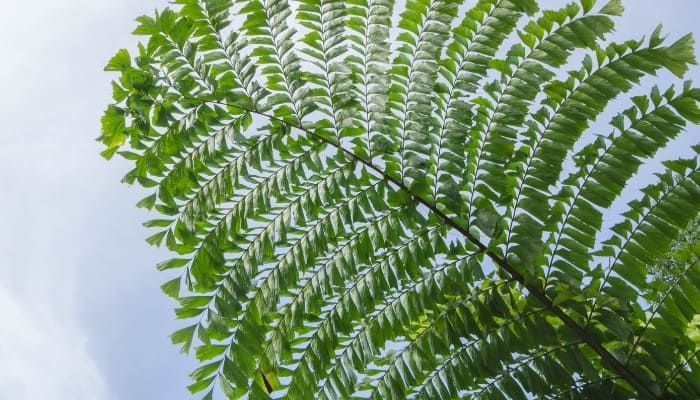
Fishtail palms are named for the rough edges and ribbed texture of their foliage, like a well-worn fishtail.
This palm grows in a dense clump of stems producing dark-green triangular leaves that gradually split as they mature.
Native to tropical Asia, this plant thrives in mid-high humidity and needs protection from cold, drafty areas to stay in good shape.
- Common Names: Burmese fishtail palm
- Average Size: 1.8 meters tall, 0.5 meter spread
- Light Requirements: Indirect light from a southeast/west-facing window
- Water Requirements: Soil should dry slightly between watering
- Growth Rate: Medium
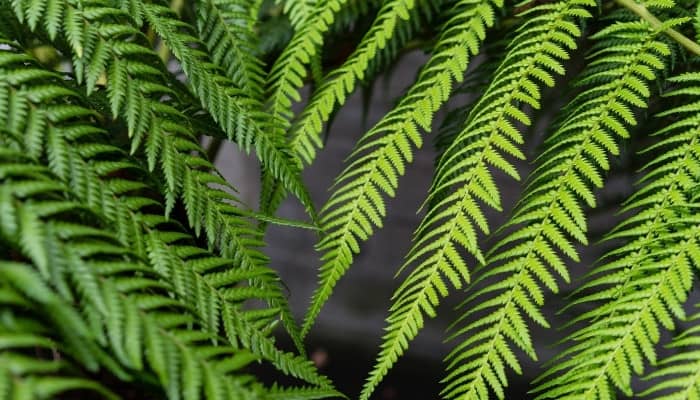
20. Australian Tree Fern (Dicksonia antarctica)
Native to the shady gullies of south-eastern Australia, the Australian tree fern commands attention with its ornamental canopy of bright-green fronds branching out from its stout, furry trunk.
Preserve the look of its delicate foliage by misting the leaves twice a week, and place the pot on a saucer of wet pebbles to raise the humidity to its preferred conditions.
- Common Names: Soft tree fern, Tasmanian tree fern
- Average Size: 3-4 meters tall, 2-3 meter spread
- Light Requirements: Partial shade, near an east-facing window
- Water Requirements: Water the trunk thoroughly once weekly and more often during hotter periods
- Growth Rate: Slow
Choose from Thousands of Trees & Plants, Delivered with Care, Directly to Your Home.
- Indoor/Outdoor
- Fruit/Flower
- Privacy/Decorative
- and more!
Indoor Trees That Thrive in Low Light – Flowering Trees
For flowering indoor trees suitable for low light, consider options like Peace Lily and certain types of Orchids (to find out more about Orchids care). These plants adapt well to indoor environments. While they offer beautiful blooms, you don’t necessarily need to provide them with a lot of sunlight. They are great for adding a floral aspect to your space without requiring intense care. Make sure you provide them with the right amount of water and indirect light to thrive.
Now, that we covered what are the best low-light indoor trees, learn what would be the best Fruit Plants for Indoor Growing!
Did you know that even some fruit trees can be successfully grown indoors? Don’t miss our list of the best varieties to try!

